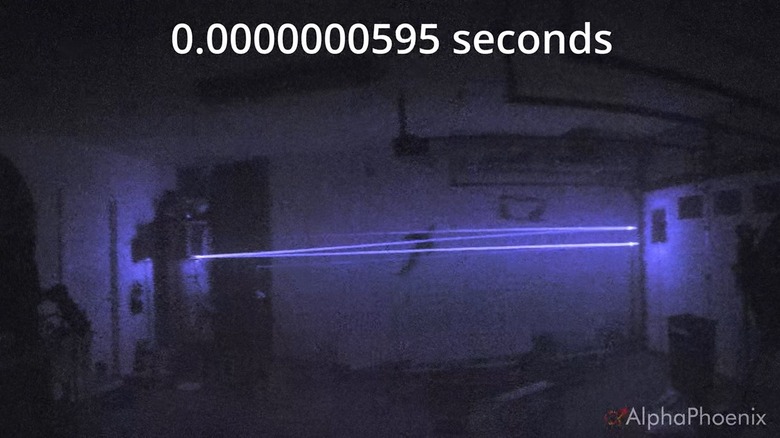Cameras Can Technically See Into The Past - Here's How
Has someone invented a time machine? Maybe. But not "Back to the Future" style like you may be thinking. Brian Haidet, with a Ph.D. in Materials Science, created a specialized camera that captures video faster than light. It's fast enough to watch light move, but also "fast enough to see the past." Haidet demos the camera on his YouTube channel, AlphaPhoenix. During an experiment, we see a laser recorded at 2 billion frames per second as it beams toward a mirror, ricocheting back to another, creating a sort of light ladder.
Technically, every camera can see into the past because of how light works. The James Webb Space Telescope peers 11.5 billion years into the past. Normally, however, cameras can't see the "propagation of light" because they don't capture at 2 billion frames per second. For reference, a single frame of video at 60 fps is equal to 33,333,333 frames of a 2-billion-fps video (2,000,000,000/60).
This is cool, but something odd seems to happen when Haidet takes another video with the camera repositioned to be closer to the light source. The outgoing light beams appear to move slower than the incoming light beams. That blue light is actually moving at a constant speed, about "six inches, or 15 centimeters, per frame of this video." Haidet also accurately calls it the "universe's speed limit." That's because the speed of light is the fastest rate of travel that we know, though, theoretically there may be other options. But for the purpose of this experiment, light "in any reference frame" will never move faster or slower than the known speed. Physicists have been able to slow down the speed of light before, but never the opposite.
Breaking down the light's apparent speed changes
So what's happening here? As the laser turns on, the light it emits travels from one direction to another, bouncing between two mirrors, creating a ladder of light. When Haidet changes the perspective of the shot, the outgoing light appears slower because the time it takes for the light from the beam to reach the camera takes longer between each frame, stretching out its time on camera.
On the return trip, as the beam gets closer, it takes less time for the light from the beam to travel to the camera between each frame. Essentially, the light from the previous frame is hot on the heels of the light from the next frame, compressing the perceived travel time. When the light is moving away from the camera, you're seeing the past stretched out in front of you, and when it's moving towards the camera, light from the past is catching up to the present.
This effect is only possible thanks to the 2-billion-fps resolution of Haidet's custom-built camera. It's important to remember that the beam never actually changes speed, it's all a trick of the light thanks to the camera's perspective.
